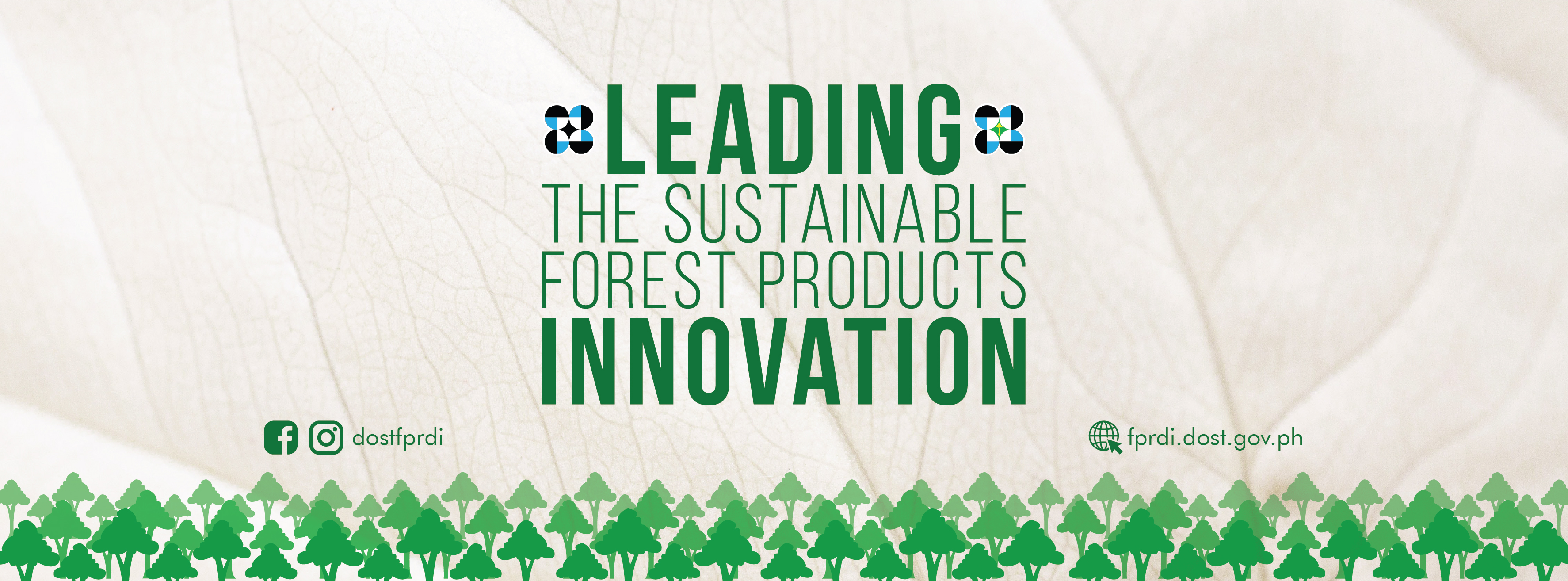The Department of Science and Technology-Forest Products Research and Development Institute (DOST-FPRDI) has published 14 research articles in prestigious journals from January 2023 to May 2024.
Of the 14 articles, 9 were published in the Philippine Journal of Science, 3 in the Journal of Tropical Forest Science, 1 in the Advances in Bamboo Science, and 1 in the Malaysian Journal of Chemistry.
“By publishing journal articles, we share the Institute’s R&D results, S&T activities, and industry knowledge to the global scientific community. Let us continue to be stewards of knowledge,” says DOST-FPRDI OIC Director Rico J. Cabangon.
Listed below are the published scientific articles including links to access the full text:
PHILIPPINE JOURNAL OF SCIENCE (https://philjournalsci.dost.gov.ph/)
1. Vol. 153, No. 1, pp. 185-198, February 2024
The fishpole bamboo [Phyllostachys aurea (Andre) Riviere and C.Riviere] in the Philippines: its properties and potential utilization
Authors: Oliver S. Marasigan, Mario Angelo M. Mundin, Shereyl A. Daguinod & Emmanuel P. Domingo
Marasigan et al. (2024) assessed the morphological, anatomical, and physico-mechanical properties of fishpole bamboo [Phyllostachys aurea (André) Rivière and C.Rivière] grown in Baguio City. This study obtained baseline information about said properties of fishpole bamboo and recommended potential applications of fishpole bamboo beyond ornamental use.
Read the full text here: https://philjournalsci.dost.gov.ph/images/pdf/pjs_pdf/vol153_No1_Feb2024/fishpole_bamboo_
in_the_Philippines_.pdf
2. Vol. 152, No. 6A, pp. 2139-2147, December 2023
Drying characteristics of pandan (Pandanus simplex Merr.) leaves using the DOST-FPRDI furnace-type dryer
Author: Juanito P. Jimenez, Jr.
Jimenez, Jr. (2023) investigated the drying characteristics of pandan (Pandanus simplex Merr.) leaves using the DOST-FPRDI's furnace-type dryer to provide an efficient drying solution. This study yielded insights on reducing the drying time and improving the overall quality of dried pandan leaves.
Read the full text here: https://philjournalsci.dost.gov.ph/images/pdf/pjs_pdf/vol152no6A_Dec2023/drying_characteristics_
of_pandan_leaves_using_the_FPRDI_furnace_type_driver_.pdf
3. Vol. 152, No. 6A, pp. 2149-2166, December 2023
Effect of locality and axial position on the properties of iron bamboo (Guadua angustifolia Kunt.) and solid bamboo [Dendrocalamus strictus (Roxb.) Nees] grown in the Philippines
Authors: Oliver S. Marasigan, Elvina O. Bondad, Mario Angelo M. Mundin & Shereyl A. Daguinod
Marasigan et al. (2023) investigated the effect of locality and axial position on the morphological, physical, and mechanical properties of iron bamboo (Guadua angustifolia Kunt.) and solid bamboo [Dendrocalamus strictus (Roxb.) Nees] from Laguna, Baguio City, and Nueva Vizcaya.
Results showed that iron and solid bamboo from Laguna are suitable for construction and engineered bamboo applications, while bamboo from Baguio City and Nueva Vizcaya is recommended for structural applications that require high strength but not necessarily large culms. These findings substantiated Philippine-grown iron and solid bamboo as eco-friendly and sustainable raw materials in green architecture.
Read the full text here: https://philjournalsci.dost.gov.ph/images/pdf/pjs_pdf/vol152no6A_Dec2023/effect_of_locality_
and_axial_position_on_the_properties_of_iron_bamboo_and_solid_bamboo_.pdf
4. Vol. 152, No. 5, pp. 1919-1929, October 2023
Investigation of chemical components of hexane extract from the stem of Arcangelisia flava via phytochemical test, GC-MS analysis, FTIR fingerprinting, and In Vitro antioxidant activity
Authors: Kimberly M. Delica, Kim Wilmer M. Balagot & Rebecca B. Lapuz
Delica et al. (2023) examined the stem of A. flava for its chemical components thru phytochemical test, GC-MS analysis, FTIR fingerprinting, and antioxidant activity. As revealed in the review of related literature, this study is the first to evaluate the chemical composition of A. flava hexane extract and identify its chemical compounds.
Read the full text here: https://philjournalsci.dost.gov.ph/images/pdf/pjs_pdf/vol152no5/investigation_of_chemical_compounds_of
_hexane_extract_from_A_flava_.pdf
5. Vol. 152, No. 5, pp. 1873-1883, October 2023
Isolation of nanocellulose by enzymatic hydrolysis of bleached Musa textilis (Abaca) pulp
Authors: Kim Wilmer M. Balagot, Kimberly M. Delica, Rebecca B. Lapuz, Anniver Ryan P. Lapuz, Rowena E. Ramos & Emmanuel P. Domingo
Balagot et al. (2023) explored the enzymatic method in isolating nanocellulose from commercial bleached S2 grade abaca pulp. Results of the study can be used as a baseline to isolate smaller particle sizes, highly monodisperse, and stable nanocellulose that can be further applied in packaging, papermaking, cosmetics, medicine, among others.
Read the full text here: https://doi.org/10.56899/152.05.28
6. Vol. 152, No. 5, pp. 1809-1822, October 2023
Gluing characteristics of giant bamboo using four commercial adhesives
Authors: Juanito P. Jimenez Jr. & James Edelbert C. Ramos
Jimenez, Jr. and Ramos (2023) determined the bonding performance of laminated giant bamboo [Dendrocalamus asper (Schult.) Backer] glued with four (4) commercial adhesives at different surface pairings and glue spread rates. This study yielded insights on producing the desirable glue bond strength for engineered bamboo.
Read the full text here: https://doi.org/10.56899/152.05.22
7. Vol. 152, No. 3, pp. 1053-1063, June 2023
Evaluation of phytochemicals, total phenolic content, antioxidant, and antimicrobial activities of Philippine forest woody vines
Authors: Kim Wilmer M. Balagot, Kimberly M. Delica, Rebecca B. Lapuz, Rowena E. Ramos & Grace Rowena B. Bisana
Balagot et al. (2023) evaluated stems of eight (8) forest woody vine species—all native to the Philippines—for their phytochemical components, total phenolic content, antioxidant, and antimicrobial activities. Results showed that these woody vines contain phytochemicals with promising antioxidant and antimicrobial properties. The findings of this study can be used as a baseline in the purification of woody vines’ bioactive components.
Read the full text here: https://doi.org/10.56899/152.03.25
8. Vol. 152, No. 1, pp. 191-204, February 2023
Potential utilization of 12 climbing bamboo species found in Luzon Island, Philippines
Authors: Elvina O. Bondad, Oliver S. Marasigan, Marina A. Alipon & Shereyl A. Daguinod
Bondad et al. (2023) determined the physical and mechanical properties of 12 species of climbing bamboo collected from Luzon. The study yielded recommendations for the local bamboo industry’s use of the assessed bamboo species (i.e., construction, high-grade furniture, flooring, paneling, bodies of musical instruments, pulp and paper, and low-grade furniture).
Read the full text here: https://doi.org/10.56899/152.01.14
9. Vol. 151, No. 6A, pp. 2081-2092, February 2023
Efficacy against molds and decay fungi of cashew nut shell liquid (CNSL) formulations applied on forest woody vines
Authors: Shirley A. Pelayo, Sheryll C. Micosa, Kennethjer G. Alejo & Alaine P. Omalin
Pelayo et al. (2023) tested the anti-termite and fungicidal properties of an organic-based preservative formulated from cashew nut shell liquid (CSNL). Results showed that while CNSL formulations varied in efficacy against molds and fungi, forest woody vines treated with CNSL + EtOH + CuCl2 proved to be the most effective against fungi after a year of exposure.
Read the full text here: https://doi.org/10.56899/152.01.03
JOURNAL OF TROPICAL FOREST SCIENCE (https://jtfs.frim.gov.my/jtfs)
1. Vol. 36, No. 1, pp. 91-104, January 2024
Physical and mechanical properties of thirteen senile fruit-bearing trees in the Philippines and their potential uses
Authors: Oliver S. Marasigan, Marina A. Alipon, Elvina O. Bondad, Karlo A. Hopia & Mario Angelo M. Mundin
Marasigan et al. (2024) evaluated the physical (e.g., green moisture content, relative density, radial shrinkage, etc.) and mechanical (e.g., shear strength, hardness, etc.) properties of 13 tree samples from Laguna and Butuan City. The samples were obtained from the following senile fruit-bearing trees:
- manggang kalabaw (Mangifera indica L.)
- manggang pahutan (Mangifera altissima Blanco)
- guyabano (Annona muricata L.)
- atis (Annona squamosa L.)
- avocado (Persea americana Mill.)
- lansones (Lansium domesticum Correa)
- santol [Sandoricum koetjape (Burm.f.) Merr.]
- nangka (Artocarpus heterophyllus Lam.)
- marang (Artocarpus odoratissimus Blanco)
- duhat [Syzygium cumini (L.)]
- bignai [Antidesma bunius (L.) Skeels]
- pomelo [Citrus maxima (Burm.)]
- chico [Manikara zapota (L.) R. Royen]
Results showed that the 13 senile fruit-bearing trees are feasible alternatives to commercial lumber, aiding the local wood sector in increasing lumber supply.
Read the full text here: https://jtfs.frim.gov.my/jtfs/article/view/2626
2. Vol. 35 No. 3, pp. 339-349, August 2023
Performance of film-forming finishes on thermally modified bolo (Gigantochloa levis)
Authors: Aralyn L. Quintos, Juanito P. Jimenez, Jr., Benjo S. Salvatierra & Ailene A. Tagolabong
Quintos et al. (2023) investigated the effect of thermal modification on the finishing properties of bolo (Gigantochloa levis). This study yielded insights on producing the desirable thermally-modified bolo applied with different finishes.
Read the full text here: https://jtfs.frim.gov.my/jtfs/article/view/2430
3. Vol. 35 No. 3, pp. 350-365, August 2023
Senile fruit-bearing trees as possible timber alternative: physical and mechanical properties
Authors: Oliver S. Marasigan, Marina A. Alipon & Elvina O. Bondad
Marasigan et al. (2023) assessed the physico-mechanical properties (e.g., moisture content, relative density, shear strength, hardness, etc.) of five (5) tree samples from Laguna, Batangas, and Butuan City. The samples were obtained from the following senile fruit-bearing trees:
- caimito (Chrysophyllum cainito)
- durian (Durio zibethinus)
- kalumpit (Terminalia microcarpa)
- rambutan (Nephelium ramboutan-ake)
- sampalok (Tamarindus indica)
Results showed that the five (5) senile fruit-bearing tree species are suitable as alternative raw materials for various end-uses to augment the supply of commercial timber. C. cainito, N. ramboutan-ake, T. indica and T. microcarpa are good for construction, furniture, cabinets, beams, flooring, panels, frames, tool handle, face veneer, and plywood production, while D. zibethinus is suited to use in light construction, panel cores, moldings, ceiling, pulp and paper, and core veneer.
Read the full text here: https://jtfs.frim.gov.my/jtfs/article/view/2431
ADVANCES IN BAMBOO SCIENCE (https://www.sciencedirect.com/journal/advances-in-bamboo-science)
- Vol. 7, No 2, p. 100081, April 2024
Dimensional stability and mechanical strength of thermally modified giant bamboo [Dendrocalamus asper (Schult.) Backer] using steam and oil
Authors: Juanito P. Jimenez, Jr. & James Edelbert C. Ramos
Jimenez, Jr. and Ramos (2024) explored the use of spent cooking oil in thermal modification of giant bamboo. This study yielded insights on enhancing bamboo stability, and reducing moisture content and dimensional changes with thermal modification using the said medium.
Read the full text here: https://doi.org/10.1016/j.bamboo.2024.100081
MALAYSIAN JOURNAL OF CHEMISTRY (https://ikm.org.my/publications/malaysian-journal-of-chemistry/)
- Vol 26, No 1, pp. 96-104, February 2024
Phytochemical screening, antioxidant, and antimicrobial properties of sequential extracts of stems of Arcangelisia flava
Authors: Kimberly M. Delica, Kim Wilmer M. Balagot, Rowena E. Ramos, Rebecca B. Lapuz, Jefferson A. Collera & Cherrie Mae J. Martinez
Delica et al. (2024) examined the antioxidant and antimicrobial properties of Arcangelisia flava, commonly known as albotra. Results showed that antimicrobial activities may be possible because of the phytochemicals identified in the extracts of A. flava stems. Moreover, this study revealed that the methanolic extract of A. flava stems is an excellent candidate for the purification and isolation of compounds responsible for antioxidant and antimicrobial activity.
Read the full text here: http://dx.doi.org/10.55373/mjchem.v26i1.96
Three more DOST-FPRDI articles will be published in the June 2024 issue of PJS and July 2024 issue of JTFS. ### (Eunice R. Decena, 06 June 2024)











